Jessica Jones loses a little steam when it gets out of the adrenaline rush that was the AKA WWJD?, AKA Sin Bin and AKA 1,000 Cuts triptych.
There is a sense that the show is not entirely sure about how exactly it wants to end; like its eponymous lead, there is an anxiety about sticking the landing. It is a problem similar to the one that faced Daredevil, which had its own issues when it come to offering a satisfactory conclusion to a season-long arc. (Indeed, Daredevil feels more like a checklist of matters that require closure rather than a story of itself.) More than that, the show has built towards a sustained climax in its eighth through tenth episodes, but there are still three hours left to fill.

Jessica Jones has always felt a little over-extended. AKA Crush Syndrome and AKA It’s Called Whiskey essentially introduced Kilgrave twice. AKA The Sandwich Saved Me, AKA Sin Bin and AKA 1,000 Cuts each feature Kilgrave captured by our heroes only to escape through various convenient means. The Will Simpson subplot fits with the themes of the season, but does feel like a stalling tactic. Malcolm provides the heart of the show, but the writers never find a convincing voice for Robyn and so their subplot also feels like padding.
So there are some basic structural issues going into the final few episodes of the season, just as there were some structural issues with the opening few episodes of the season. Nevertheless, Jessica Jones does make a number of clever decisions as it builds towards its conclusion. Instead of ramping up and outwards, as would be the natural impulse, the show begins narrowing its focus and winding down. AKA I’ve Got the Blues and AKA Take a Bloody Number are surprisingly intimate in their scope following the scale of the show’s climax.

The tendency is always to “end big”, to push a story to its limits in terms of size and scale. Storytelling logic suggests that the stakes should keep building in order to preserve momentum and sustain the audience’s emotional investment. Escalation has become one of the cornerstones of blockbuster storytelling on both the large and small screens. Perhaps fueled in part by cost-effective CGI, it seems more and more common for television and film to put the fate of the world (or the universe) up for grabs.
It often feels like spectacle becomes an end in and of itself in these sorts of stories. Even classic children’s characters are no longer safe. Tim Burton’s Alice in Wonderland and Joe Wright’s Pan transformed their protagonists from lost children in magical realms to chosen ones prophecised to liberate entire worlds. Peter Jackson’s adaptations of The Hobbit even took on the tone of his Lord of the Rings trilogy, transforming a sweet and charming folk tale into a large-scale epic. Everything is bigger, louder, more epic in scope.
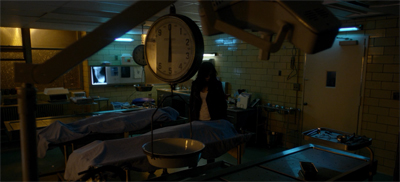
Blockbuster script doctor Damon Lindelof explained that this storytelling trend is arguably rooted in the commercial realities of modern movie-making, where the money invested in a property dictates the scale of the story being told:
“Once you spend more than $100 million on a movie, you have to save the world,” explains Lindelof. “And when you start there, and basically say, I have to construct a MacGuffin based on if they shut off this, or they close this portal, or they deactivate this bomb, or they come up with this cure, it will save the world—you are very limited in terms of how you execute that. And in many ways, you can become a slave to it and, again, I make no excuses, I’m just saying you kind of have to start there. In the old days, it was just as satisfying that all Superman has to do was basically save Lois from this earthquake in California. The stakes in that movie are that the San Andreas Fault line opens up and half of California is going to fall in the ocean. That felt big enough, but there is a sense of bigger, better, faster, seen it before, done that.”
“It sounds sort of hacky and defensive to say, [but it’s] almost inescapable,” he continues. “It’s almost impossible to, for example, not have a final set piece where the fate of the free world is at stake. You basically work your way backward and say, ‘Well, the Avengers aren’t going to save Guam, they’ve got to save the world.’ Did Star Trek Into Darkness need to have a gigantic starship crashing into San Francisco? I’ll never know. But it sure felt like it did.”
It should be noted that the scale of the climax rarely directly correlates with quality. Few superhero fans would credibly argue that planet-wide threat and city-wide destruction of Man of Steel resulted in a more iconic Superman story than Richard Donner’s original efforts.

That said, it should be noted that the level of destruction is not noticeable different. After all, Superman and Zod’s confrontation in Metropolis at the climax of Man of Steel is just a more effects-laden and visually-impressive reiteration of the same fight at the climax of Superman II. Michael Shannon’s Zod might have wanted to destroy the world, but Terrance Stamp’s Zod wanted to rule it. The biggest difference is arguably that of tone; Man of Steel relishes its computer-enhanced devastation while Superman II puts less emphasis on the death and horror.
There is a sense of formula to all this, as if studios and audiences have reached an unspoken understanding that the climax of a superhero story has a minimum threshold of carnage and devastation. Ant Man was widely praised for reversing this trend, featuring a climax that found the hero and villain staging their final battle inside a child’s bedroom; however, the movie still featured an obligatory big action set piece involving the destruction of a laboratory and a brawl on a helicopter. The impulse is always there.
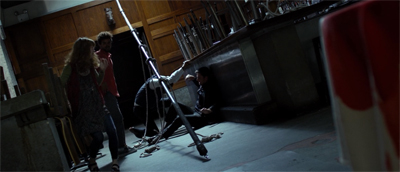
The problem with such scale is that it can become a little repetitive and lifeless. The climaxes of The Avengers, Guardians of the Galaxy and The Avengers: Age of Ultron all escalated to the point where dropping one half of a city on top of the other half of a city seemed like a middling supervillain ambition. The extent to which these climaxes worked (or didn’t work) is not rooted in the scale of the threat, but the integrity of the characters involved in the climax. The audience roots for the characters, not the background.
This is arguably the smartest decision made by Jessica Jones in its final few episodes; the show pulls back the scale and tightens its focus. Admittedly, the brutality of AKA 1,000 Cuts helped thin the grass a little bit; Jeri is entirely absent from AKA I’ve Got the Blues and AKA Take a Bloody Number, Hope is no longer an on-going concern, and even Detective Clemons is not around to serve as a representative of the NYPD. However, the structure of the episodes in question helps to make the focus seem decidedly more intimate.
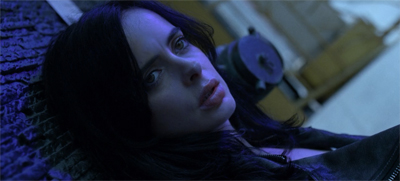
The narrative focus of these episodes is tighter, with less seeding of plot threads to pay off down the line. AKA I’ve Got the Blues is one of only two episodes in the season that does not feature David Tennant as Kilgrave. Although Kilgrave is still a focus, he is not an active player in the episode’s drama. Will Simpson serves as the primary antagonist of the episode, whether killing armed goons in Trish’s hallway or tearing through Jessica’s apartment. Simpson is carted away at the end of the episode, his role in the drama played out.
As AKA I’ve Got the Blues and AKA Take a Bloody Number allows Jessica to work through one threat at a time, dealing with Simpson before focusing on Kilgrave, the episodes also tighten Jessica’s social circle. At the end of AKA I’ve Got the Blues, Robyn makes it clear to Malcolm that the survivors’ group has disbanded. Jessica is no longer embroiled in Jeri’s divorce battle. Instead, AKA I’ve Got the Blues and AKA Take a Bloody Number each focus on Jessica’s two strongest relationships; her relationship with Trish and her relationship with Luke.
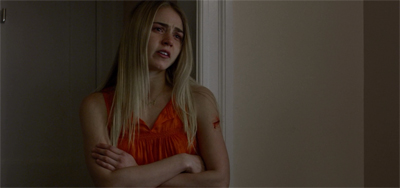
Trish is an interesting character in the context of Jessica Jones. Along with the reworking of Kilgrave’s character to turn him into the show’s primary antagonist rather than simply the focus of the last arc, Trish represents a fairly sizable departure from Brian Michael Bendis and Michael Gaydos’ Alias run. In the original comic book, Jessica Jones was best friends with the character Carol Danvers rather than Patricia Walker. Carol Danvers is, of course, the secret identity of the character originally known as “Miss Marvel”, but recently rebranded “Captain Marvel.”
There are a whole host of reasons why Carol Danvers was off-limits to the production team working on Jessica Jones. Most obviously, Marvel Studios is consciously gearing towards a Captain Marvel feature film scheduled for release in March 2019. The role has yet to be cast, causing obvious problems with using the character in Jessica Jones. More than that, the high-profile actor the studios are looking for seems unlikely to appear as a co-star on a Netflix show. Even then, Disney might balk at a scene of Captain Danvers receiving oral sex.
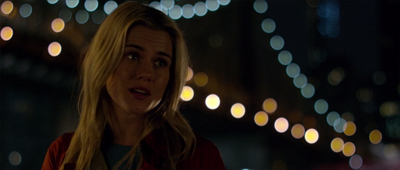
Producer Melissa Rosenberg was initially upset at the fact that the character was unavailable to her. Danvers had been part of the original show developed at ABC, with the change reflecting the tightened focus of the Marvel business model as the show came under their umbrella:
Well back in the network ABC day I had Carol Danvers, who’s in the book, right from the source material. That relationship was important in the book and I loved that friendship. When it finally got to Netflix and by then Carol Danvers [aka Captain Marvel] was going to have her own movie, all I knew was I couldn’t have her and I threw a fit. Then one of our colleagues at Marvel brought up Patsy Walker, who I’d never heard of. I’m not the biggest comic book aficionado, but Patsy’s had her own series since the ’40s. It was very girly. She’s a model, and she has boyfriends and she wears these fabulous outfits. There was this really rich material in her backstory about being a child star, and about having a stage mother and her life exploited.
It represents a fairly sizable loss to the story, with Carol Danvers serving as perhaps the strongest connection between Jessica Jones and the world of conventional superheroism. (Jessica Jones also ditches a subplot involving Scott Lang, likely for similar Paul-Rudd-related reasons.)

Then again, the loss might not be such a big deal. Part of the beauty of Alias lay in the book’s intertextuality; in the way that Bendis and Gaydos used the comic to explore the Marvel universe through the prism of subjects usually unexplored. One of the hallmarks of Bendis’ approach to the larger Marvel universe is a willingness to explore the racial, sexual and class implications of the shared universe. Sometimes this is a commentary on contemporary American society; sometimes it is an exploration of the genre’s own blind spots.
While Alias worked very well as an exploration of trauma, it also served as something of a critique of certain decisions that had been made at Marvel in the past. Alias is incredibly critical of the Avengers themselves, arguably as a metaphor for both Marvel’s own editorial decisions and also as a commentary on public attitudes towards assaults. One of the recurring ideas in Alias is that nobody actually cares about Jessica Jones, that she slips through the cracks of the Marvel universe. When she is abducted for eight months, no one notices.
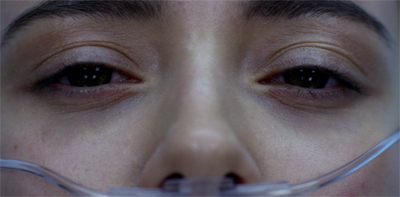
This is a very powerful metaphor for how broader culture engages with certain crimes against women and how support structures are not always in place for the victims of horrible trauma. Jessica Jones handles this metaphorical aspect of the story quite well, using Kilgrave as the living embodiment of sexual trauma and institutional misogyny. However, Alias was also tightly woven into the fabric of the Marvel universe, to the point that Bendis was originally “toying with” the idea of using a real third string hero (Jessica Drew) rather than creating a new one.
After all, Alias touches on all manner of issues that are out of reach of the television show. The opening arc focuses on Captain America’s secret identity. The next features Rick Jones. Then it’s anti-mutant prejudice. Alias also feels like a criticism of The Avengers as a comic book institution. After all, The Avengers was a comic that infamously featured the team willingly leaving Carol Danvers in the care of mind-controlling rapist who also happened to be her son. The male characters in the comic (and the male editorial staff) seemingly missed the horror of the decision.
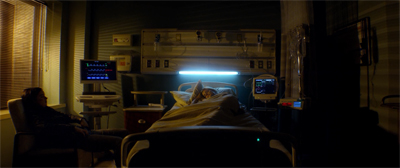
In that issue, an all-male Marvel staff, presided by Jim Shooter and watched by the Comics Code, slaughtered Marvel’s symbol of modern women, Ms. Marvel. They presented her as a victim of rape who enjoyed the process, and even wound up swooning over her rapist and joining him of her “free” will. Such a storyline might have fit into the 1950s, when people actually believed such a thing was possible — I mean, they thought that women invited and enjoyed rape back then — but to present such a storyline today shows a collection of medieval minds at work. Or at vicious play. For such a storyline to pass through the echelons of editor, editor-in-chief, and Comics Code can only be a crime.
That storyline casts a long shadow, and provides important cultural context for her appearance as Jessica’s best friend in Alias.

The plot is convoluted, as many comic plots tend to be. It is tied to characters with interlinked and interconnected histories, with temporal paradoxes and continuity references galore. The long and short of the plot has Carol suddenly becoming pregnant and giving birth after only three days; it turns out that this plan was concocted by a mysterious villain named Marcus, who wanted to be born on Earth. It turns out that Marcus abducted Carol, seduced her “with a subtle boost from Immortus’ machines”, impregnated her and wiped her memory.
The actual mechanics of this are incredibly creepy, with Marcus essentially mind-controlling, date-raping and memory-wiping his own mother in order to father himself. The Oedipal subtext plays through the story, with Marcus alternately addressing her as “Carol”, “my love” and “mother.” Comic books are creepy. At the end of the story, after suffering through that ordeal and arguably still under Marcus’ influence, Carol decides to go live with her rapist/son. And the Avengers decide to let her. It is not a good moment for anybody involved in that story, inside or out.
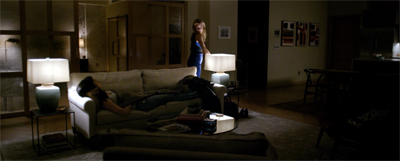
In fact, Miss Marvel writer Chris Claremont explicitly called out the company’s editors for their handling of the whole affair, both in having Carol herself call it out in Avengers Annual #10 and in The X-Men Companion II:
Avengers #199, where Carol Danvers is introduced to the Avengers, and they’re told that in two days she has become eight months pregnant by an unknown father, or by force of persons unknown, and the reaction of the entire crowd, men and women both, is to the effect of: “Can I babysit?” “Can we knit booties?” “Can I make cookies for the baby?” “Oh you must be so happy?” and my reaction was, “What an insensitive crowd of boors.” Actually, my reaction was a lot stronger than that. But how callous! How cruel! How unfeeling! Considering that these people must have seen Ms. Marvel only a couple of days before, or even a couple of months before. She wasn’t pregnant then. How could she be eight months pregnant now? Now, if that had been the point David [Michelinie] was trying to make, that these other Avengers are callous boors, okay then, I may disagree with the point, but if he followed through on it, it would have made sense. But it seemed to me, looking at the story, looking at the following story, that he was going for: “This is how you respond to a pregnancy.”
It is proof of how blind comic books could be on subjects like this, and precisely why a comic book like Alias was so sorely needed, even in the context of the new millennium.
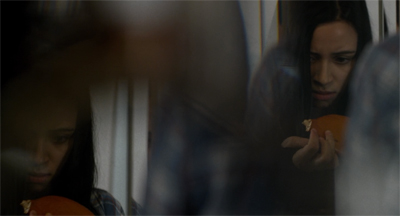
In Alias, it is Carol Danvers who recognises that Jessica is in trouble. After the Purple Man forces Jessica to attack the Avengers and the Defenders, the groups both turn on her. Thor and the Vision go after Jessica with reckless abandon. Nobody seems to recognise that she is a member of their fraternity; nobody pauses to question what is going on. Nobody even tries to restrain her. It is Carol who intervenes at the last minute to save Jessica from the beat-down. Although never mentioned, it is suggested she understands exactly what is happening.
In many respects, Jessica’s trauma in Alias is an update of the Carol’s trauma. Like Carol, Jessica finds herself at the whim of a mind-controlling sadist. Like Carol, Jessica is abandoned by her friends. Like Carol, what was going on should have been incredibly obvious. Bendis just uses all these familiar elements to construct a feminist story about the inadequate response and sensitivity to issues like that. Obviously mind-controlling rapists do not exist in real life, but the institutions and authorities are similarly ill-equipped to help victims cope and recover.

As such, Carol’s presence in Alias was really just an extension of the comic’s wider engagement with the history and context of the shared Marvel universe. The Marvel cinematic universe does not share a lot of that history, and trying to shoehorn it into the narrative would feel awkward or contrived. More than that, it seems highly unlikely that Marvel would allow a story as critical of the Avengers and their response to Jessica’s ordeal as Alias suggested. In light of all that, it makes sense to writer Carol out; she could not serve the same (or even a similar) purpose.
Using Trish Walker allows Melissa Rosenberg and her team a greater degree of freedom. In fact, Trish has one of the more interesting arcs of the season. AKA Ladies’ Night set Trish up as the obligatory “best friend” character, only for episodes like AKA Crush Syndrome and AKA It’s Called Whiskey to peel back the layers and reveal a more complicated individual. Although Trish carries herself very differently to Jessica, her character is just as informed and defined by the traumas that she has experienced.
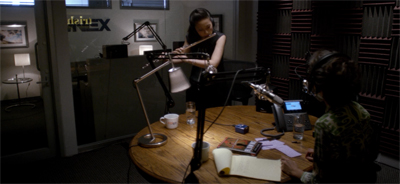
Although Trish Walker did not appear in Alias, she is a Marvel character with a long history; longer than that of Jessica Jones or Luke Cage or Zebediah Killgrave. Trish actually predates Marvel comics as it exists today; she was created before Iron Man of the Fantastic Four or the Incredible Hulk. She first appeared in November 1944, when what would become Marvel was known as “Timely Comics.” As such, Trish Walker is a bit of Marvel pre-history carried over to the modern universe that launched in the sixties; like Captain America, Namor and Ka-Zar.
Trish Walker was originally a romance comic, a genre that largely fell by the wayside during the fifties and sixties. (There have been some recent attempts to restart the genre as part of larger efforts to diversify the medium.) Patsy Walker was slowly incorporated into the Marvel universe, in the same way that classic concepts like the Golden Age Human Torch or the Golden Age Angel were gslipped back into continuity along their newer Silver Age counterparts. Stan Lee and Jack Kirby slipped a cameo into the Fantastic Four annual where Reed and Susan Richards married.
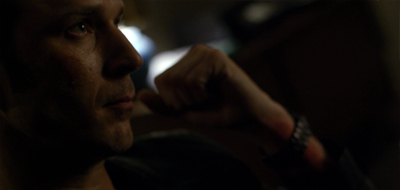
It was writer Steve Englehart who hit upon the idea of transforming Trish into a superhero. As he told Back Issue:
Questioned in connection with this article, the veteran author recalls that girls’ walk on in Fantastic Four “struck my fan’s eye by including her in the Marvel Universe. So when I got my chance to do strange things in comics, I though it would be cool to bring her in as a real character, with things to do. Part of my ‘training’ as a Marvel writer was writing romance stories and Westerns, but Patsy was defunct as a comic by the time I got there so I never wrote anything about her previous to ‘The Beast.’ Still, as a fan, I had collected everything Marvel, including Patsy Walker and Patsy and Hedy – toward the end of their runs, they had moved into a running soap opera, which I enjoyed – so I knew them as characters, and enjoyed exploring Patsy in the MU.”
Trish reinvented herself as the costumed hero Hellcat, who was Beast’s girlfriend and eventually an Avenger.

The transition between romance and superhero comics might not be as radical as it first appears. Englehart describes the late Patsy Walker comics as “a running soap opera”, but that term is just as applicable to long-running superhero comics. Superhero stories share a lot of narrative conventions with soap operas, including “never-ending stories, characters with complex histories and a preponderance of long-lost relatives (evil twins or otherwise).” After all, they are pulpy long-form serialised narratives.
Although reductionist and stereotypical, there is some truth in the assertion that comic books are “soap operas for boys.” They arguably just more emphasis on violence than romance. (The same is true of wrestling to a certain extent.) The entire Marvel universe could be summarised as “one ridiculously vast cosmic soap opera about a huge cast of characters brawling and teaming up and falling in love and living and dying and living again, told in tens of thousands of saddle-stapled installments by scores of different artists and writers.”
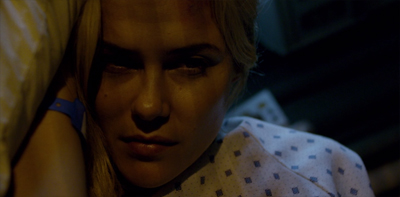
As a character who has transitioned from a genre primarily considered feminine (romance comics) to a genre primarily considered masculine (superhero comics), Trish Walker is arguably the perfect character for Jessica Jones. The show is largely about exploring trauma from a feminine perspective, in marked contrast to the default (and stereotypically) masculine outlook associated with superhero comics. Trish has navigated these traditional gender boundaries before, so the character is well-suited to the story being told.
It is true that more and more women are reading comics, to the point where they currently make up almost half the market. However, this is a relatively recent development; during the nineties, Neil Gaiman’s ability to attract female comic book readers was considered an anomaly. This is why there is such a vocal (and radical) backlash to changes like allowing Jane Foster to replace Donald Blake as Thor; even marginal support or encouragement for female audiences is considered “female encroachment on a traditionally male space.” (See also: Sam Wilson as Cap.)

Aside from the metatextual joys of repurposing Trish Walker for Jessica Jones, the character works very well in her own right. She provides a marked contrast to Jessica, dealing with her own issues. Indeed, AKA I’ve Got the Blues suggests that the two characters have fostered something of a co-dependence. Trish kept Jessica’s gifts secret and Jessica helped Trish to break free of her mother’s noxious influence. AKA I’ve Got the Blues renders Trish’s abuse in explicit terms, suggesting that her mother is just another iteration of the same exploitative entitlement as Kilgrave.
However, while Jessica seems to have responded to her trauma by locking everybody else out, Trish seems to have responded by letting everybody in. Trish hosts the top-rated radio talk show in New York; her face is plastered all over billboards and she provides a voice (and an ear) to the entire city. Trish publicly advocates for Hope Slottman in AKA It’s Called Whiskey, despite never having met the girl; while they try to help in their own ways, neither Jeri nor Jessica are willing to get on a platform to support the innocent victim.
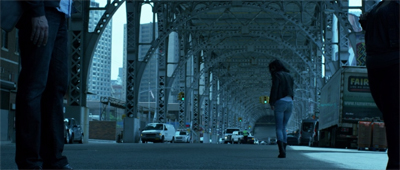
More than that, Trish opens herself up to Will Simpson. After his assault on her in AKA It’s Called Whiskey, Trish welcomes Simpson into her home in AKA 99 Friends and into her bed in AKA The Sandwich Saved Me. Even as it becomes increasingly clear that Simpson cannot be trusts, Trish refuses to cut him out of her life. Even after he physically abuses her again in AKA 1,000 Cuts, this time under the influence of drugs rather than Kilgrave, Trish refuses to firmly reject him in AKA I’ve Got the Blues.
Trish is clearly suspicious of Simpson in her dealings with him, unsure of whether she can trust him. However, she seems sincere when she promises to talk with him “later”, and does not immediately reject his idea of dinner. In AKA Take a Bloody Number, Trish even advocates for Simpson after he locks her away and tried to murder Jessica. “He was a good guy,” Trish insists. “No, he wasn’t,” Jessica cynically responds. Trish responds, “He was before those drugs turned him into Godzilla.” Perhaps the truth lies somewhere in the middle.
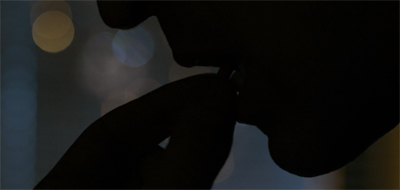
(As with the rest of the season, AKA I’ve Got the Blues is decidedly ambiguous as to how sympathetic Simpson is. In his own way, Simpson is an addict relapsing in the face of trauma. If Malcolm is not entirely culpable for his drug addiction under Kilgrave’s influence, is Simpson accountable for his addiction to steroids in response to Kilgrave’s attack? The scene between Jessica and Simpson in the apartment shrewdly casts Simpson’s face in faint purple light; a visual suggestion that perhaps Kilgrave’s toxic influence is at work even in an indirect manner.)
One of the recurring motifs of the season is the idea that trauma recurs. For a show about control and responsibility, the motif might be better framed as a relapse; there is a sense that patterns of events tend to play out time and time again. Simpson returns to the super soldier programme that messed him up in the past. Trish finds herself making excuses for another abusive influence in her life. Even Jessica cannot stop herself from hurting Luke. Just like Jessica’s door is repeatedly broken over the course of the thirteen-episode run, some things just keep recurring.
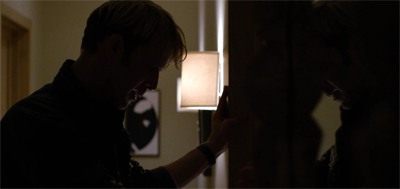
(It is tempting to use this motif as a justification for some of the show’s weaker plotting decisions. Does the show’s decision to introduce Kilgrave twice play into the notion of recurring trauma? What about the three times that Kilgrave is captured, only to escape from the clutches of our heroes? Perhaps these also play into the theme of cycles of behaviour. However, that feels like stretching the metaphor just a little bit too far. Sometimes a questionable plotting decision is just a questionable plotting decision.)
Rachel Taylor does great work as Trish, playing very well off Krysten Ritter as Jessica. Indeed, the friendship between Trish and Jessica serves as one of the truly consistent elements spanning from AKA Ladies’ Night through to AKA Smile. Sure, everything ends up okay with Luke in the end, but none of the show’s other relationships seem quite as stable or reliable as the friendship between these two characters. There is a sense of genuine love between the two, with Jessica Jones offering a convincing depiction of co-dependence and reliability.

While it would be very easy for Jessica Jones to treat Trish as a walking cash machine and exposition device, the show invests her with her own agency and agenda. More than that, the show also demonstrates that the relationship is a two-way street. While AKA Ladies’ Night and AKA Crush Syndrome suggest that Jessica might just be using Trish for her money and her access, the rest of the series does a good job of explaining just what Trish gets out of the relationship. AKA The Sandwich Saved Me is particularly insightful in this regard.
Indeed, it is worth noting that Jessica decides to take Trish with her to confront Kilgrave in AKA Smile. Although Luke Cage might have superpowers and Claire Temple might be able to invite Matt Murdock along, Jessica decides that she would rather have Trish by her side for the climactic confrontation. AKA I’ve Got the Blues is consciously building towards the climax of AKA Smile in how it chooses to define the relationship between Jessica and Trish. There is some nice set-up and pay-off at work.

“What if he took somebody you loved?” Trish ask Jessica at one point in AKA I’ve Got the Blues. Jessica wryly responds, “Luckily I don’t have too many of those.” It is a very effective set-up for the well-earned “I love you” at the climax of AKA Smile. Indeed, for all that the show might occasionally feel over-extended, Jessica Jones does a good job setting up that final confrontation between Jessica and Kilgrave in AKA Smile, with AKA Sin Bin consciously set up to invert the “captive in control” dynamic that comes into play.
AKA I’ve Got the Blues is notable for being one of only two episodes not to feature David Tennant. (The other is AKA 99 Friends.) As ever, Jessica Jones does an excellent job cultivating Kilgrave as a threat even when Tennant is not around; Jessica begins to see flashes of purple everywhere, paranoid about the character’s noxious influence. Nursing a bruise from a collision with a car, Jessica reflects, “Purple’s his favourite colour and he didn’t even have to give it to me.” Purple shines on Simpson’s face in Jessica’s office.

The effectiveness of Kilgrave’s presence despite (or even because) of Tennant’s absence reinforces the idea that the start of the season might have worked better by pushing Kilgrave into the background for a while, allowing world-building and character-development without needing to involve him. One of the biggest issues with Jessica Jones is the sense that the central plot is a little stretched and over-extended at points, padded out to reach a target runtime. Taking some time without Kilgrave at the start of the season might have helped.
As with AKA Sin Bin and AKA 1,000 Cuts, there is a sense that the production team are having some fun with the binge-watching model. AKA I’ve Got the Blues arrives ten hours into the thirteen-episode cycle. The adrenaline-infused highs of AKA Sin Bin and AKA 1,000 Cuts are starting to dissipate; the caffeine hit is wearing off. Those viewers eagerly consuming the show are likely to be exhausted by this point, their tiredness mirrored in that of Jessica and Trish; after all, Jessica Jones can be quite heavy at times.

In fact, the show pulls quite a mean-spirited trick on those viewers who might be a little worn out after ten hours staring at a computer screen. When Jessica is hit by the van, the show cuts to black; this is expected. However, the pause is remarkably long, and the return to consciousness comes in bursts of scrambled images and audio. Particularly tired viewers might be forgiven for worrying that their laptops died or that Netflix cut out or that there is something wrong with the feed. It is a nice jolt, a sly nod to the show’s distribution model.
After the culling in AKA 1,000 Cuts, AKA I’ve Got the Blues marks a refocusing of the show as it gears up towards the finalé.
You might be interested in our other reviews of the first season of Jessica Jones:
- AKA Ladies’ Night
- AKA Crush Syndrome
- AKA It’s Called Whiskey
- AKA 99 Friends
- AKA The Sandwich Saved Me
- AKA You’re a Winner!
- AKA Top Shelf Perverts
- AKA WWJD?
- AKA Sin Bin
- AKA 1,000 Cuts
- AKA I’ve Got the Blues
- AKA Take a Bloody Number
- AKA Smile
Filed under: Television | Tagged: aka i've got the blues, carol danvers, comic books, Jessica Jones, patsy walker, rachel taylor, soap operas, trish walker |




















This show is front-loaded with Tennant. How much more Tennant could this be? The answer is none. None more Tennant.
“…a superhero story has a minimum threshold of carnage and devastation.”
Which explains why Kilgrave kills or maims somebody in nearly every scene.
“It is tempting to use this motif as a justification for some of the show’s weaker plotting decisions.”
It seems a lot of visual language will go wasted on someone who is unfamiliar with comics or the gender politics. Apart from insiders, not many people will pick up on these things, except maybe subliminally. (Maybe that’s enough.) And it’s not like there’s a wealth of blogs talking about the history behind the show… All I hear is twittering about a “defenders team-up” as though that’s the point of it all.
I’m actually worried about that. Do I drift too far off on tangents? I mean, it’s not as if you need to know any of the history of Luke Cage or Trish Walker – let alone the importance of Carol Danvers to the comic and her omission from the series. But, as you said, it does give my reviews a unique angle, at least.
No, I think these are valuable insights.
Moreover, it’s not always easy to tell when the audience is being played and when you’re just watching bad TV!
If what you’re suggesting is true (and I believe it is) than Jessica Jones is trying to defy superhero convention and provoke some feelings of unease. I still think the show is a flawed success, with a 50-50 hit rate, but I’ll admit I think more kindly of it having read these recaps.
Finally, I want the show to succeed. And the chances of that are improved if the audience is able to think critically. We have a problem in America of having our stories pre-digested, because that makes us better consumers. Luckily the obscurity of JJ is doubled-edged; it makes for a less comprehensible show (imagine if they pulled some of this shit with a big tentpole movie!) but that fact it’s Marvel means everyone is going to give it a fair shake regardless.
Plus it’s just fun to talk about it. 😀
Jessica Jones definitely has its problems. It could have done with tighter pacing and a better structure to start. It’s between three and five episodes too long, depending on how generous you feel. But it is doing some very clever things in a very bold way. And I think that getting away with so much of that under the Marvel brand is – as you point out – a very good thing.
Also, I’m loving the actors who play young Jess and Trish — particularly Liz Cappuccino. (What a name.) The “It’s Patsy” theme song had me rolling.
It’s also a nice gag because it harks back to Tennant’s wonderful line-reading of “It’s Patsy!” in AKA WWJD. (It’s also beautifully framed as well. He literally pokes his head into the frame to suggest she could come over. Coupled with his nods, it’s a delightfully hilarious/creepy piece of comedy.)